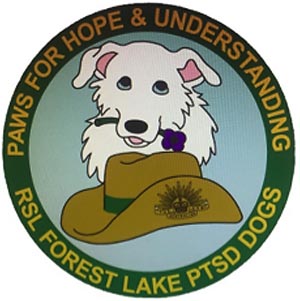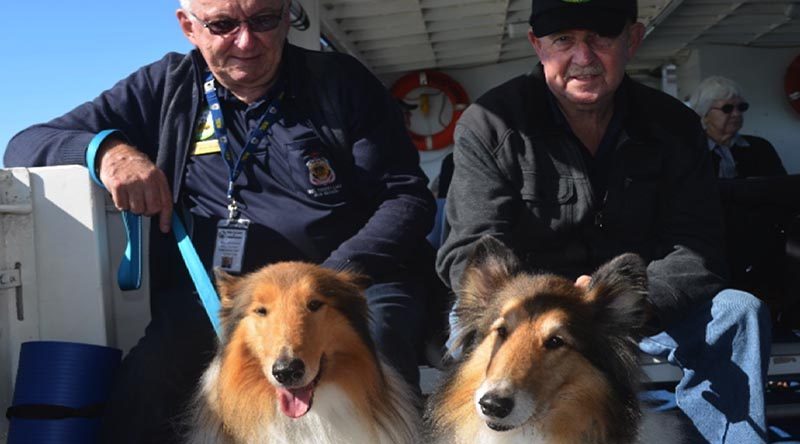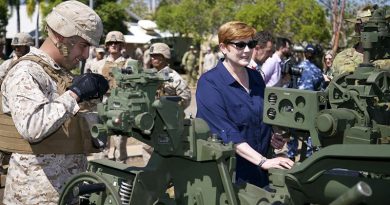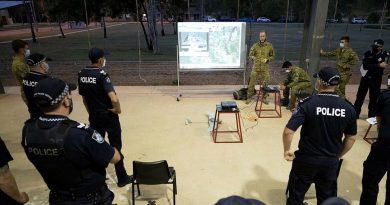Introducing the Forest Lake Service/PTSD Dog Program
Share the post "Introducing the Forest Lake Service/PTSD Dog Program"

IN MY DARKEST HOUR, I REACHED FOR A HAND AND FOUND A PAW
Less than 40% of veterans with PTSD will seek treatment, of these 4 out of 5 veterans are prescribed medications and referred to therapy by their doctors.
CAPTION: A couple of Aussie veterans and their service dogs.
According to AAPP, Department Veteran Affairs, PTSD Foundation USA, there are five options for treatment:
- Medication
- Therapy sessions
- Service Dogs
- Assistance Dogs
- Experimental

What assistance do PTSD Service Dogs deliver?
- Provide Companionship
- Calm Their Handler
- Assist in Medical Crisis
- Provide treatment related assistance
- Assist in coping with emotional overload
- Perform security enhancement tasks
- Assist with episodes of stress/trauma(PTSD)
- Prevent people from crowding or rushing
- Guide veteran through crowds
A Service/PTSD dog would become a full companion for an individual veteran.
Delta Therapy dogs can be seen doing the rounds of hospitals, visiting the sick and elderly or staying with a person at work who is having trouble with day to day events after suffering a death in the family. By comparison, a PTSD Service dog fills a highly specific role and is trained to work with incapacitated defence personnel, or retired members now confined to a wheelchair or suffering with balance issues, or members who suffer with PTSD, Traumatic Brain Injury (TBI) or service personnel who require trained dogs that can respond to their needs.
WHAT IS THE FOREST LAKE RSL – SERVICE/PTSD DOG PROGRAM?
 Forest Lake RSL – Service/PTSD dog program has been designed to take the training of service dogs concept to a new level.
Forest Lake RSL – Service/PTSD dog program has been designed to take the training of service dogs concept to a new level.
- Training period for the dog is 12 weeks in which that period covers area such as discipline, obedience and the Public Asset Test in the community.
- Training period for the client is a further twelve weeks to enable the client and dog work as a team
- A further 6-12 weeks to obtain a team with both handler and dog.
Post-traumatic stress disorder is a form of anxiety disorder. Some people develop this condition after they have experienced a traumatic event.
This event might be a serious accident, physical or sexual assault, war or torture, or a natural disaster such as a bushfire or a flood.
Strong reactions such as fear, horror, anger, sadness and hopelessness are natural after events like these, of course. In most cases, these feelings will pass after the normal working-through of emotions and talking things over in your own time with family, friends or colleagues.
In the past, PTSD was referred to as combat fatigue, shell shock – or in the early days, cowardice – and mostly associated with those in the armed forces.
In more recent years people have come to realise that those serving on the ‘front line’ at home, in the police force, ambulance and fire service are also at increased risk of developing PTSD through what they face almost daily.
HOW DO SERVICE DOGS ASSIST?
There are many types of service/assistance dogs, and some even serve multiple purposes.
Potential service dogs go through rigorous training programs before they can team up with a handler.
Here are just a few types of service dogs:
- Guide Dogs for the blind
- Hearing Dogs for deaf or hearing-impaired persons
- Mobility Assistance Dogs for wheelchair-bound persons or those with mobility limitations
- Seizure Response Dogs to protect and help persons with seizure disorders when a seizure occurs
- Diabetes Assistance Dogs to detect blood sugar highs and lows (dogs are scent-trained)
- Mental Health Service Dogs or Psychiatric Service Dogs are task-trained to assist those with PTSD, panic disorders, anxiety disorders, major depression, Autism Spectrum Disorders and much more.
New research conducted by the University of Queensland into scent training with service dogs for epilepsy veterans, is being trialled by Paws for Hope & Understanding in conjunction with the University.
For Ex and current Defence personnel, PTSD is often triggered by being in combat or experiencing significant stress or trauma.
For those in the emergency services, it is often triggered by life threatening experiences, such as being stuck in a burning building, being shot at, having to deal with a terrifying road side accident or domestic abuse situation.
Basically, they are situations where people feel intense fear and or helplessness.
Within some groups of society, the incidence of PTSD must be expected to be much higher than one per cent.
According to David Kinchin, Author, Post-Traumatic Stress Disorder, the incidence of PTSD within the armed forces can be as high as 15% and this does not include suicide statistics.
HOW DO YOU KNOW WHEN SERVICE DOGS ARE ON THE JOB?
- Service dogs can be easily identified. By Law, all wear special vests and/or harnesses. However, identification is required.
- Never assume – always be sure to ask before petting a dog
- Service dogs should not be petted, fed or otherwise given attention while at work. Please be respectful and allow these dogs to do their jobs. They make a major difference in the lives of disabled persons.
THE WAY FORWARD……
Congress in the USA, plus the UK government now recognise the benefits of specifically trained dogs as part of the treatment for PTSD, extensive research is also being carried out in Canada.
Further research was carried out in the USA in 2014.
Additional studies have also been conducted in to the relationship between a dog and veteran, the bond that develops and the result of that bond.
Focus on this relationship proved that this bond released chemicals in the brain – oxytocin.
Oxytocin improves trust, the ability to interpret facial expressions, the overcoming of paranoia and other pro-social effects – the opposite of PTSD symptoms.
It’s been proven that dogs can draw out even the most isolated people, and through engaging with a dog a veteran can overcome emotional numbness (a symptom of PTSD).
Through training a dog, veterans develop new ways to communicate without anger or paranoia.
It has also been proven through research that veterans were also able to sleep again knowing a dog was looking out for them.
By bonding with a dog emotionally, veterans felt more able to engage themselves.
If you are an ADF member or former member and are diagnosed with PTSD accepted by the DVA or a psychiatrist, and you need help, the Forest Lake RSL Service/PTSD dog program may be for you.
Contact Bob on 0412747529 for further information.
.
.
.
.
.
.

.
.
Share the post "Introducing the Forest Lake Service/PTSD Dog Program"






I would like to receive more information on your program I do have chronic ptsd chronic anxiety , manic depression. For many mints at a time some times almost up to a year. Just depending on the time of year , the amount of flash backs , and if I get my manic depression at the same time I can’t cope with the outside world I am on Ndis. I have good support team. But sadly not enough at present.
Kindest Regards
Anika jade Dillon
I would like more information about your PTSD dog programme. Do you assist people train their own dogs or do I need to get a new dog?
I am ex-air force with 14 years service and I have PTSD accepted by DVA.